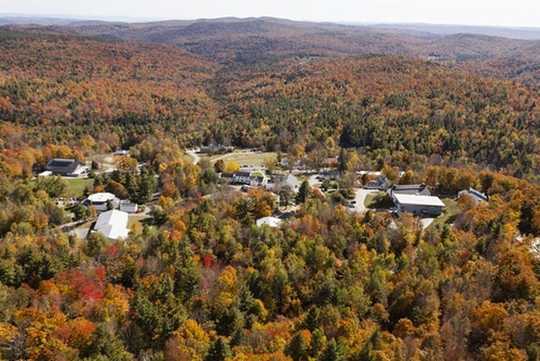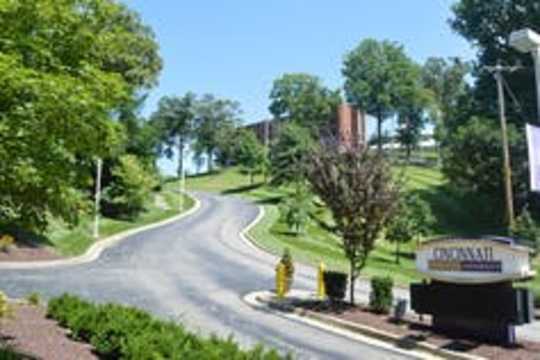
Marlboro College plans to close its Vermont campus after the 2019-2020 school year and move its programs to Emerson College in Boston. Wikimedia Commons, CC BY-NC-SA
When Cincinnati Christian University became aware of its declining enrollment and dwindling tuition revenue in 2015, the university made a “series of bold bets” to stay afloat.
But the bold moves ended up being a series of strategic mistakes. The school started a football team, revised its mission and laid off faculty and staff to cut costs. It spent most of its $4 million endowment but was still $6 million in debt in 2018. This fall semester will be the school’s last.
Cincinnati Christian College is one of a growing number of colleges and universities – 21 private colleges since 2016 – forced to close their doors for financial reasons. The trend has affected the public sector, too. At least 33 public colleges – including community colleges – have consolidated within their state systems or merged with other institutions since 2016.

Cincinnati Christian University is set to close at the end of 2019. Wikimedia Commons, CC BY-NC-SA
And predictions of the future demise of other colleges abound. Harvard Business School professor Clayton Christensen has said that half of all colleges and universities will close in the next decade. While that view may be overly pessimistic, one study found that about 800 of the approximately 2,300 four-year public and nonprofit private colleges in the nation exhibited characteristics that put them at financial risk: They had fewer than 1,000 students, had no online programs, imposed annual tuition increases of at least 8% and relied on tuition for 85 percent or more of their revenue. They also discounted their tuition by 35 percent or more.
These college closures disrupt the academic lives of students, force faculty and staff to find work elsewhere and can hurt a local economy.
As an education professor who has served as the chief enrollment officer at several universities for 30 years, here are four reasons I believe are behind the closures.
1. Rising prices and doubts about value
Talk to any parent of a college-bound high school student and they will express concern about the cost of college. When I conducted research as a consultant for a small college, I found that price was by far the biggest factor in how both parents and students chose a college.
In that 2019 unpublished study, sticker price was the top consideration for 51 percent of parents when making a college choice. That’s three times the 17 percent who said academic reputation – as determined by college rankings published by various magazines – was a top factor.
We can expect to see more colleges face declining enrollment as prices continue to increase. The College Board reports that average tuition and fees tripled at public four-year colleges and more than doubled at nonprofit private colleges from academic year 1989 to 2019 – after accounting for inflation.
As college prices continue to rise, more people are questioning whether college is worth the price.
According to a 2019 survey of 1,389 Americans, only 58% think colleges are doing a “good” or “very good” job of providing students a return on their investment. Although the survey found that 69 percent had favorable views of four-year colleges, respondents also wanted colleges to help students acquire the skills needed to get a good-paying job.
When the value of college is questioned, the first schools that experience enrollment declines are those that aren’t very well known, aren’t very selective, rely heavily on tuition and offer large discounts to attract and keep students.
2. Demographic shifts
Amid rising college costs, the income gap between rich and poor is also getting wider. From 1988 to 2018, the bottom 20% of Americans, in terms of income, saw a 12 percent increase in their income, while those in the top 20% enjoyed a 51% increase, according to The College Board.
This is particularly true for African American and Hispanic families. In his 2015 book, “Breakpoint,” Jon McGee notes that average incomes of African American and Hispanic families are half those of whites and Asians.
Nathan Grawe’s 2018 book, “Demographics and the Demand for Higher Education,” shows that while the number of high school graduates nationwide will increase slightly between now and 2025, that number will actually decrease by 15-20% in the Northeast, which is where many nonprofit, private colleges are located. The increase occurs in the South and Southwest, primarily in the Hispanic population, with lower average incomes. Grawe estimates that the share of Hispanics going to college will increase by about 5 percentage points by 2029, while total student enrollment will decrease by almost 8 percent between 2025 and 2029.
So, while America’s colleges and universities are expected to enroll a more diverse student body in the coming years, they will also face financial strain as fewer students enroll and more families lack the means to pay tuition.
3. Colleges as competitors
It used to be that colleges could share student information with one another to make sure they were able to offer a price that was in line with the needs of a student’s family.
All that changed in the early 1990s, when the Department of Justice initiated an antitrust investigation of 57 private, nonprofit colleges and universities for alleged price fixing. A consent decree stipulated that colleges were no longer permitted to share financial aid data of students who had applied to different institutions.
That one action changed the competitive landscape forever, leading many colleges to offer more competitive “scholarships,” which in many cases are actually non-need-based discounts. As this practice escalated in recent years, colleges bid against each other for students by offering more generous scholarships. This creates a major financial strain as institutions spend money that they don’t really have and forgo revenue they need.
4. Colleges move too slowly
Colleges and universities are not known for nimble behavior. Those institutions that move fast, such as Southern New Hampshire, Arizona State and Western Governors universities, benefit by getting new programs to market ahead of others.
But that’s not true for most. Brian Mitchell, a former president of Bucknell University and now a higher education consultant, claims that many college trustees are “woefully unprepared” to meet the challenges facing their institutions. Most colleges address enrollment and revenue declines by simply increasing the discount rate to enroll more students. This, Mitchell says, demonstrates a fundamental “misunderstanding of the overall state of higher education” and makes it difficult to achieve meaningful change.
Take the College of New Rochelle in New York, for example. Administrators there discovered “fabricated budgets” in 2016, at least three years after those budgets were closed. Subsequently, an internal audit uncovered $31.2 million in unpaid bills, including state and federal payroll taxes. The college did not close until 2019. The board of trustees was not aware of the debt, nor was the debt listed in its annual audit. Delayed action and management errors effectively killed this once-vibrant institution.
What it takes to survive
In times of economic and demographic downturns, the smallest and weakest of colleges and universities will be challenged to survive. However, if institutions are clear about their missions but willing to expand them; if they welcome change in who their students are, which programs they offer and how they deliver those programs; and if they anticipate the impact of negative headwinds while moving quickly and smartly, they should be able to navigate the choppy waters ahead of them and survive.
About the Author
Robert Massa, Adjunct Professor, Rossier School of Education, USC, University of Southern California
This article is republished from The Conversation under a Creative Commons license. Read the original article.
Recommended books:
Capital in the Twenty-First Century
by Thomas Piketty. (Translated by Arthur Goldhammer)
 In Capital in the Twenty-First Century, Thomas Piketty analyzes a unique collection of data from twenty countries, ranging as far back as the eighteenth century, to uncover key economic and social patterns. But economic trends are not acts of God. Political action has curbed dangerous inequalities in the past, says Thomas Piketty, and may do so again. A work of extraordinary ambition, originality, and rigor, Capital in the Twenty-First Century reorients our understanding of economic history and confronts us with sobering lessons for today. His findings will transform debate and set the agenda for the next generation of thought about wealth and inequality.
In Capital in the Twenty-First Century, Thomas Piketty analyzes a unique collection of data from twenty countries, ranging as far back as the eighteenth century, to uncover key economic and social patterns. But economic trends are not acts of God. Political action has curbed dangerous inequalities in the past, says Thomas Piketty, and may do so again. A work of extraordinary ambition, originality, and rigor, Capital in the Twenty-First Century reorients our understanding of economic history and confronts us with sobering lessons for today. His findings will transform debate and set the agenda for the next generation of thought about wealth and inequality.
Click here for more info and/or to order this book on Amazon.
Nature's Fortune: How Business and Society Thrive by Investing in Nature
by Mark R. Tercek and Jonathan S. Adams.
 What is nature worth? The answer to this question—which traditionally has been framed in environmental terms—is revolutionizing the way we do business. In Nature’s Fortune, Mark Tercek, CEO of The Nature Conservancy and former investment banker, and science writer Jonathan Adams argue that nature is not only the foundation of human well-being, but also the smartest commercial investment any business or government can make. The forests, floodplains, and oyster reefs often seen simply as raw materials or as obstacles to be cleared in the name of progress are, in fact as important to our future prosperity as technology or law or business innovation. Nature’s Fortune offers an essential guide to the world’s economic—and environmental—well-being.
What is nature worth? The answer to this question—which traditionally has been framed in environmental terms—is revolutionizing the way we do business. In Nature’s Fortune, Mark Tercek, CEO of The Nature Conservancy and former investment banker, and science writer Jonathan Adams argue that nature is not only the foundation of human well-being, but also the smartest commercial investment any business or government can make. The forests, floodplains, and oyster reefs often seen simply as raw materials or as obstacles to be cleared in the name of progress are, in fact as important to our future prosperity as technology or law or business innovation. Nature’s Fortune offers an essential guide to the world’s economic—and environmental—well-being.
Click here for more info and/or to order this book on Amazon.
Beyond Outrage: What has gone wrong with our economy and our democracy, and how to fix it -- by Robert B. Reich
 In this timely book, Robert B. Reich argues that nothing good happens in Washington unless citizens are energized and organized to make sure Washington acts in the public good. The first step is to see the big picture. Beyond Outrage connects the dots, showing why the increasing share of income and wealth going to the top has hobbled jobs and growth for everyone else, undermining our democracy; caused Americans to become increasingly cynical about public life; and turned many Americans against one another. He also explains why the proposals of the “regressive right” are dead wrong and provides a clear roadmap of what must be done instead. Here’s a plan for action for everyone who cares about the future of America.
In this timely book, Robert B. Reich argues that nothing good happens in Washington unless citizens are energized and organized to make sure Washington acts in the public good. The first step is to see the big picture. Beyond Outrage connects the dots, showing why the increasing share of income and wealth going to the top has hobbled jobs and growth for everyone else, undermining our democracy; caused Americans to become increasingly cynical about public life; and turned many Americans against one another. He also explains why the proposals of the “regressive right” are dead wrong and provides a clear roadmap of what must be done instead. Here’s a plan for action for everyone who cares about the future of America.
Click here for more info or to order this book on Amazon.
This Changes Everything: Occupy Wall Street and the 99% Movement
by Sarah van Gelder and staff of YES! Magazine.
 This Changes Everything shows how the Occupy movement is shifting the way people view themselves and the world, the kind of society they believe is possible, and their own involvement in creating a society that works for the 99% rather than just the 1%. Attempts to pigeonhole this decentralized, fast-evolving movement have led to confusion and misperception. In this volume, the editors of YES! Magazine bring together voices from inside and outside the protests to convey the issues, possibilities, and personalities associated with the Occupy Wall Street movement. This book features contributions from Naomi Klein, David Korten, Rebecca Solnit, Ralph Nader, and others, as well as Occupy activists who were there from the beginning.
This Changes Everything shows how the Occupy movement is shifting the way people view themselves and the world, the kind of society they believe is possible, and their own involvement in creating a society that works for the 99% rather than just the 1%. Attempts to pigeonhole this decentralized, fast-evolving movement have led to confusion and misperception. In this volume, the editors of YES! Magazine bring together voices from inside and outside the protests to convey the issues, possibilities, and personalities associated with the Occupy Wall Street movement. This book features contributions from Naomi Klein, David Korten, Rebecca Solnit, Ralph Nader, and others, as well as Occupy activists who were there from the beginning.
Click here for more info and/or to order this book on Amazon.























